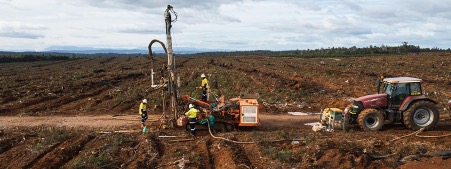ABx Group Limited’s (ASX: ABX) latest assay results which confirm a 6.5km mineralised channel connecting the company’s Deep Leads and Rubble Mound rare earth discoveries, located in northern Tasmania.
The clay-hosted rare earth elements (REE) occur within a shallow channel structure that increases the prospect size by 27% to 5.1 sq. km and demonstrates the potential for the mineralised zone to deliver thick intersections as well as expand significantly along strike. The combined prospective area to be drill tested has increased to more than 30 sq. km.
“Our latest results represent a milestone moment in our development of the rare earth channel at Deep Leads and Rubble Mound. The extensive channel structure has connected and combined the two discoveries into a single deposit and, excitingly, the mineralisation has also been shown to return results which are thick – exceeding 20 metres thickness – and near surface,” ABx Group MD and CEO, Dr Mark Cooksey, said.
“These are only first-pass results, with this emerging discovery possessing clear potential to significantly expand the mineralised corridor between the connected areas as well as along strike.
“The assays confirm the rare earth oxides encountered are rich in the four high-value ‘permanent magnet’ elements that are critical for advanced technologies, such as electric vehicles, smart phones and wind turbines.
“Furthermore, not all clay-hosted rare earths are created equal. Only those clay deposits formed by ionic adsorption of REE metals onto clays (IAC REE) achieve high extraction rates at low cost and are the most sought-after deposits.
ABx Group has confirmed Deep Leads possesses these ionic adsorption clays and has successfully delivered extraction rates of 50% to 75% of contained REE using benign, low-cost processing techniques. ABx is the first to discover true IAC REE in Tasmania.”
Assay results confirm the adjoining mineralisation contains excellent grades, with holes such as RM217 returning a maximum of 2511 ppm of total rare earth oxide (TREO). This hole has also proven that the channel can host thicker intercepts, in this case to a depth of over 20 metres. Further work will be required to assess the size and depth potential of this connected area.
To date, rare earths encountered have typically been concentrated in buried channel structures of six to 12m depth. However, the latest results demonstrate the region’s capacity to host even shallower mineralisation, with RM219 recording a 1m assay grading 1884ppm TREO at surface.
These results will feed into a maiden JORC Resource Estimation, which is already underway.
Upcoming drilling campaign
The receipt of the company’s latest assay results has increased ABx’s confidence in its geological interpretation and will inform targeting work for an upcoming drilling program, anticipated to commence in October 2022.
The campaign is pending government approvals with most proposed drill site locations already falling under a previously approved work programme.
During this campaign, ABx intends to complete approximately 70 drill holes with much of this work focussed on stepping out from the known northwest trending channel. The company will also test in-fill targets between Deep Leads and Rubble Mound, as well as inspect a new style of REE mineralisation encountered in alluvial flats to the south of the project. For further information please visit: https://www.abxgroup.com.au












